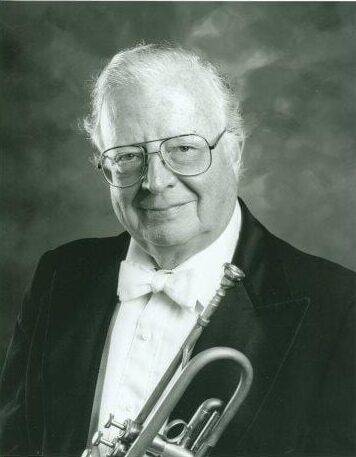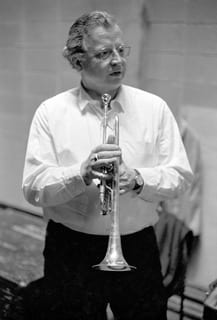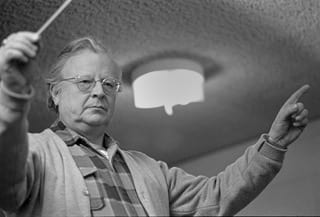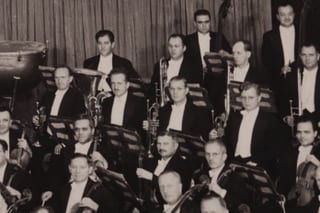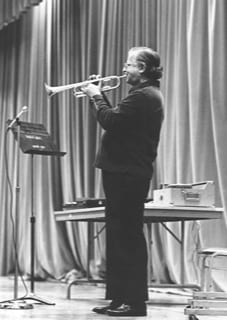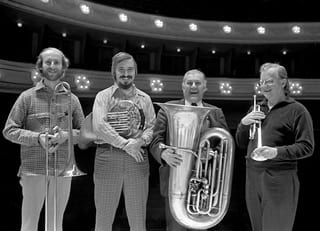Audience member: Mouthpieces!
Mouthpieces! Well, get one that feels good. And it’s got to make the kind of sound you want, and that’s all it really needs to do. Uh, the mouthpieces that I prefer to use are, well they’re Bach mouthpieces because that’s what I’ve played on since I was a kid, you know. I think my first trumpet, that Conn trumpet I told you about, had a 7C mouthpiece. A Bach 7C mouthpiece came with it. That’s always been the most, the biggest seller I guess in that entire line because it’s kind of medium sized, not too big, not too small.
And I liked a basic mouthpiece, but I switched mouthpieces actually after I had an injury to my lip here. I broke some teeth, and busted my lip in an automobile accident, and I had about fifty stitches across here and so on. After that I was playing on a plain seven mouthpiece which is a deeper one than a 7C, more like a cornet kind of a cup; V-shaped, you know. But it felt very small so I said to Mr. Bach, “Will you please send me three or four of your largest mouthpieces?” I said, “The scar tissue swells up, you know, when I play.”
And so he sent me (mouthpiece sizes) a “1”, and a “1 1/2”, and a “1C”, and I guess a “1 1/4C”; and I really liked the number one (‘1”) the best. It seemed to have the fullest sound. So I changed to it right away. I got those mouthpieces on a Monday morning in the mail, and I tried them real quick before I went to the rehearsal. And we were playing Bruckner 7, by the way, with Carl Bohm from Vienna and Salzburg. He just died a year or so back (1894-1981). A very fine conductor!
And I thought, “Well, I’ll try this Bruckner 7” It’s a very strenuous piece. “I’ll try that with this mouthpiece and if I can get through that with this mouthpiece, well then, okay. Good.” So I used that number one mouthpiece for the concerts that week—we played it four times at the concerts. And it felt marvelous, I had actually more range, more endurance and more sound, naturally, because it was a bigger mouthpiece. Lots of people get small mouthpieces. They give you more range, but that’s not necessarily true.
So I’ve been playing on either a plain “1” or a “1B” which is still not listed in the catalog, but it’s a mouthpiece they make. I think they take some other B-shaped cutter and then they expand it to fit to the screw-rim. As a matter of fact, the mouthpiece I have is the first 1B that Bach ever made. And some of the people don’t want to put it in the catalog for some reason or another. I don’t talk to them anymore anyway, so… But I go back and forth between the one and the one 1B. The 1B is more like a cornet cut, a little more V-shaped, you know, and it plays a little different. Those are my two favorite mouthpieces now but I don’t say to anybody, “You should play my mouth pieces.” That’s too much of an individual matter. Whatever works for you. They have some wonderful-sounding players who play on what I would call small mouthpieces, but they sound marvelous, so what can you say?
I have found that I like to put a bigger hole in the mouthpiece. Most of us, I guess, you know, drill out that little hole or have it drilled out, the one in here. I don’t know what you call it here. We call it the throat of the mouthpiece, and we call this the back bore from here on. The terminology is different everywhere. And we very often have this part of it opened up a little bit wider, too, you know. It broadens the sound a little bit and makes it play a little bit more freely. If you want to play stronger there’s more there, you know.
As far as the rim shape is concerned, I understand Maurice and Pierre and most people like a very flat rim. I don’t like a flat rim. Again, that’s personal, you know. And Maurice, he plays with a dry lip. He wipes the mouthpiece, and brings it up. If I did that I wouldn’t be able to find the place. You know, I’d be over here, I’d be over here. I can’t move it and then… But again, that’s an individual matter, you know.

